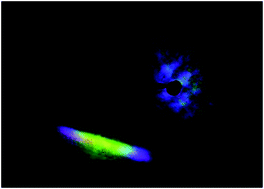当前位置:
X-MOL 学术
›
Nanoscale Adv.
›
论文详情
Our official English website, www.x-mol.net, welcomes your feedback! (Note: you will need to create a separate account there.)
Ultra-dense, curved, grating optics determines peacock spider coloration
Nanoscale Advances ( IF 4.7 ) Pub Date : 2020/02/21 , DOI: 10.1039/c9na00494g Bodo D Wilts 1 , Jürgen Otto 2 , Doekele G Stavenga 3
Nanoscale Advances ( IF 4.7 ) Pub Date : 2020/02/21 , DOI: 10.1039/c9na00494g Bodo D Wilts 1 , Jürgen Otto 2 , Doekele G Stavenga 3
Affiliation

|
Controlling light through photonic nanostructures is important for everyday optical components, from spectrometers to data storage and readout. In nature, nanostructured materials produce wavelength-dependent colors that are key for visual communication across animals. Here, we investigate two Australian peacock spiders, which court females in complex dances with either iridescent color patterns (Maratus robinsoni) or an approximately angle-independent blue coloration (M. nigromaculatus). Using light microscopy, FIB-SEM imaging, imaging scatterometry, and optical modeling, we show that both color displays originate from nanogratings on structured 3D surfaces. The difference in angle-dependency of the coloration results from a combination of the local scale shape and the nanograting period. The iridescence of M. robinsoni arises from ordered gratings on locally flat substrates, while the more stable blue colors of M. nigromaculatus originate from ultra-dense, curved gratings with multiscale disorder. Our results shed light on the design principle of the peacock spiders' scales and could inspire novel dispersive components, e.g. used in spectroscopic applications.
中文翻译:

超高密度、弯曲、光栅光学元件决定了孔雀蜘蛛的颜色
通过光子纳米结构控制光对于从光谱仪到数据存储和读出的日常光学组件非常重要。在自然界中,纳米结构材料会产生与波长相关的颜色,这些颜色对于动物之间的视觉交流至关重要。在这里,我们调查了两种澳大利亚孔雀蜘蛛,它们以复杂的舞蹈向雌性求爱,它们具有彩虹色图案 ( Maratus robinsoni ) 或近似与角度无关的蓝色 ( M. nigromaculatus ))。使用光学显微镜、FIB-SEM 成像、成像散射测量和光学建模,我们表明这两种彩色显示器都源自结构化 3D 表面上的纳米光栅。着色的角度依赖性差异由局部尺度形状和纳米光栅周期的组合引起。M. robinsoni的彩虹色来自于局部平坦基板上的有序光栅,而M. nigromaculatus更稳定的蓝色来自具有多尺度无序的超密集弯曲光栅。我们的研究结果揭示了孔雀蜘蛛鳞片的设计原理,并可以激发新的色散组件,例如用于光谱应用。
更新日期:2020-03-19
中文翻译:

超高密度、弯曲、光栅光学元件决定了孔雀蜘蛛的颜色
通过光子纳米结构控制光对于从光谱仪到数据存储和读出的日常光学组件非常重要。在自然界中,纳米结构材料会产生与波长相关的颜色,这些颜色对于动物之间的视觉交流至关重要。在这里,我们调查了两种澳大利亚孔雀蜘蛛,它们以复杂的舞蹈向雌性求爱,它们具有彩虹色图案 ( Maratus robinsoni ) 或近似与角度无关的蓝色 ( M. nigromaculatus ))。使用光学显微镜、FIB-SEM 成像、成像散射测量和光学建模,我们表明这两种彩色显示器都源自结构化 3D 表面上的纳米光栅。着色的角度依赖性差异由局部尺度形状和纳米光栅周期的组合引起。M. robinsoni的彩虹色来自于局部平坦基板上的有序光栅,而M. nigromaculatus更稳定的蓝色来自具有多尺度无序的超密集弯曲光栅。我们的研究结果揭示了孔雀蜘蛛鳞片的设计原理,并可以激发新的色散组件,例如用于光谱应用。



























 京公网安备 11010802027423号
京公网安备 11010802027423号